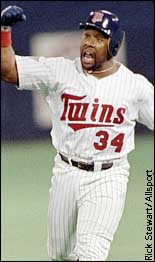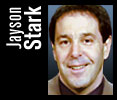Once, life was simple. You had your National League. You had your
American League. They met in October. Their All-Stars met in July.
They had their own separate offices. They had their own separate presidents.
They had their own separate umpires. They even had their own separate
baseballs.
That's the way it was in 1901. That's the way it was forever -- until now.
|  | | Part of the World Series drama is the intrigue of American League vs. National League. |
Now, though, life isn't so simple. You may have noticed that.
Those separate league presidents have gone the way of Fred Flintstone's
brontosaurus. Those separate umpiring crews have taken a ride through Bud
Selig's blender. And those separate league baseballs now have been replaced
with the ever-popular King Bud autograph models.
But that's not all, of course. Another round of interleague play starts
any week now. Right after that comes the vote to approve Selig's latest
realignment plan, which has Arizona and Tampa Bay switching
leagues. And the commish says he'd love to see more realignment down the road.
Stand back and take a long look at this big picture, and what do you see?
You see traditions crumbling. You see history fading.
You see two leagues gradually being smushed into one large, increasingly
indistinguishable ball. That's what you see.
It is all being done in the name of progress, naturally. The schedule is
a disaster. Those 1901 league rules don't apply to much of anything anymore.
And consistency in umpiring is a concept that wasn't addressed for way too
many decades.
So we're all for fixing problems in the name of progress, because
progress is great. But too much progress can be not so great. So before the
commish takes any more steps to blur the distinction between the two leagues,
we offer this advice:
STOP.
Do not pass go. Do not collect 200 million dollars. Do not mess further
with one of the few remaining qualities that makes baseball different and
special.
No one argues which conference in hockey is better -- the east or the
west. No one could give two crosschecks about it. But people still debate
whether the American League is superior to the National League. And we hope
they always will.
But there's no need to get esoteric in this argument. All we really need
to do to prove that there is something tremendous about preserving some
serious distinctions between the leagues is to utter exactly two words:
|
“ |
Personally, I'm totally against
interleague play. I'd say, 'Get rid of it.' The luster
of interleague play has totally worn off. The only
places it's still great are New York, Chicago and
Los Angeles. Everywhere else, it hasn't done
much. ” |
|
|
— Mark McGwire |
Junior Griffey.
What's that buzz all about when Griffey and his Reds come to some new
town these days? What's the explanation for the Reds leading every team in
baseball in road attendance (at 37,968 paying customers per game)?
It's not about Pokey Reese or Dante Bichette or Scott Williamson. It's
about one thing: Griffey-mania.
And not because Junior is some 19-year-old phenom just bursting on the
scene. Heck, no. He's been in the majors since 1989, accumulating more
highlight-tape time than Chris Berman.
But not in the National League, he hasn't. In places like St. Louis and
Houston and Atlanta, literally millions of fans have never laid eyes on him
in real life.
So in those places, he's practically a mythical sporting demigod, cloaked
in mystery, suddenly dropping out of the clouds to appear on a whole new
set of diamonds, right there, live and in person.
"Every place we go," says Reds manager Jack McKeon, "they want to see
Griffey. And if I were them, I would too. When we made this trade, I heard
from everybody. I heard from my grandchildren. They got on the phone, saying:
'Grandpa, grandpa, you got Ken Griffey.' That's the kind of excitement this
thing has created."
How different is Griffey's existence, just because of this league switch?
In Philadelphia a couple of weeks ago, he couldn't even figure out how to get
into the ballpark. The cab driver didn't know where to drop him off. So there he
was, Mr. All Century Team himself, wandering around the parking lot, looking
for the door.
"I was just trying to find my way in, asking a whole bunch of questions,"
Griffey says. "Luckily, I finally found the lady sitting at the front desk.
She said, 'Just go down here and turn left.' I said, 'Yeah. All right.' "
Think how absurd this is -- 12 seasons into his career, and Junior
couldn't find his way into a stadium that's practically older than he is?
But if there were no such thing as a National League and an American
League, we wouldn't be telling you this story. And the world would be a worse
place for that.
Griffey claims that outside of stuff like getting lost, he doesn't think
his life has changed much. But he's wrong. Testifying to that is a
man who understands better than anyone what switching leagues can do to a
guy's career: Ladies and gentlemen, Mr. Mark McGwire.
"I don't know if it exactly changed my whole career," McGwire says. "But
it definitely boosted the level of excitement.
"That was the coolest thing about it," says McGwire, now more relaxed and
at home with those changes than he's ever been. "People got so excited. I
played in the American League for 11 years, and I never went to any National
League cities east of San Francisco. I never even went to Colorado or
Arizona. So just to see the excitement -- people coming out and cheering like
that -- it was something I'd never experienced."
One minute, McGwire was just another great slugger. The next, he was Babe
Ruth coming back to life and traveling the Senior Circuit.
"I'll never forget my first day I came over here after the trade," he
says. "I took batting practice in Philadelphia. And that was the day my
batting practice became the big show before the game. I took batting practice
in the American League all those years, and it was no big deal. But I took
batting practice that first game in Philadelphia, and it was all anybody
talked about. The next thing you know, there were 20,000 fans watching
batting practice. And it was all because of the trade.
"All of a sudden, the big thing was: 'Come see this guy take BP.' I was
playing a game before the game. Talk about stress. I'm so used to it now, I
just laugh. But back then, I was, like, 'What's going on?' "
What was going on? Easy question. It was the joy of discovery.
In any other sport, it would be just about impossible for this phenomenon to
occur to someone that deep into his career. But since the leagues pretty much kept to themselves, and when interleague play came about it was so limited, voilá. Mark McGwire was reborn.
And now it's Junior's turn.
"What's been fun to watch," says Reds coach Tom Hume, "is how he'll come
to bat for the first time in these towns, and all he hears are 'Yays.' But
after that, as the game goes on, he becomes the enemy. It's great, though. It
was his first time in Shea Stadium, his first time Pittsburgh, his first time
in Philadelphia. Here, he's played 11 years, and he's never been to any of
those places. And I like that. I like that we have two different leagues. I
hope it doesn't change.
"There's got to be some kind of uniqueness that we keep in our game --
something special, something different, something that's sacred just for our
game."
Hey, amen to that. But how to hold onto that?
Next year, interleague opponents will begin to rotate. And you know there will be those who want more and more interleague play. But it's up to baseball to make sure that interleague play remains extremely
limited.
Under the rotation currently planned, most teams would visit a city in the
other league only once every six or eight years. McGwire thinks even that is
too often.
"Personally, I'm totally against interleague play," he says. "I'd say,
'Get rid of it.' The luster of interleague play has totally worn off. The
only places it's still great are New York, Chicago and Los Angeles.
Everywhere else, it hasn't done much. So I think we should get rid of it and
really keep the leagues separate, so when a guy does switch leagues, we can
keep that (same) excitement."
Well, we hate to break it to the big guy, but they're not going to get
rid of it. They're never going back to the way life used to be. And we're all
going to have to accept that.
But we hope baseball still pays attention to the words of Mark McGwire -- and the lessons of Mark McGwire. In part, he and Griffey created their own
phenomena. But in part, baseball created it, too, by maintaining some
semblance of its long tradition -- a tradition that, in many ways, still works
for the sport and not against it.
So as baseball rushes to embrace the future, this is our way of
reminding it to remember the past. We hope there is never a time when the
National League and American League mean as little as "NFC" and "AFC" mean in
a certain other sport.
What's in a name? What's in these names? Just ask Mark McGwire. We rest
our case.
Jayson Stark is a senior writer at ESPN.com. | |
ALSO SEE
Jayson Stark archive

|



